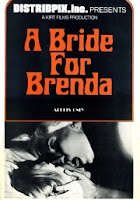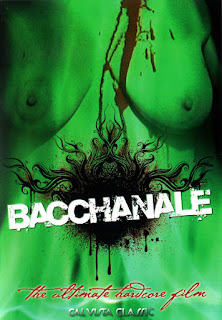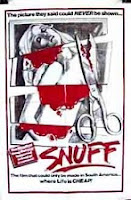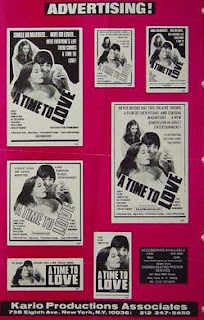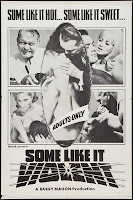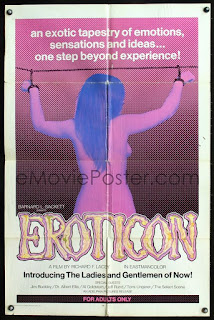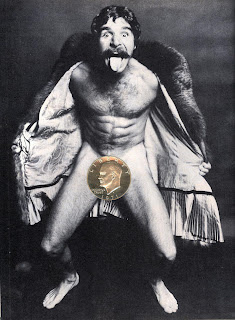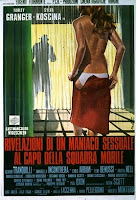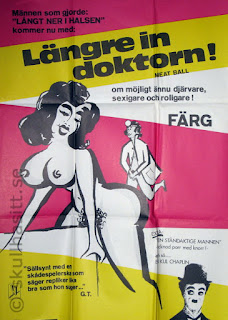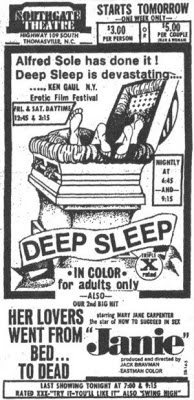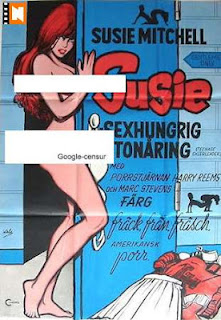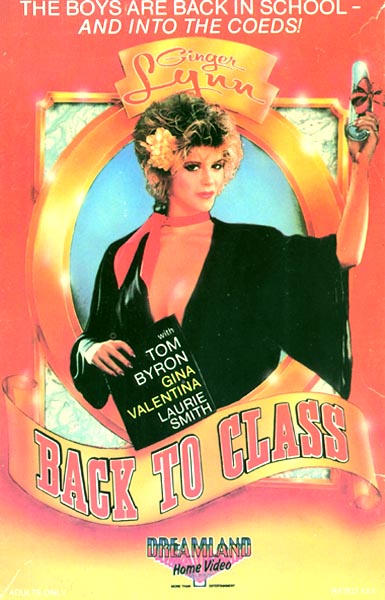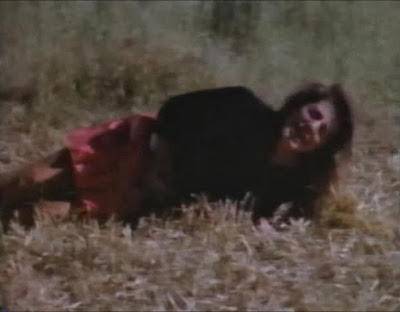27 August 1947 – 19 March 2013
Go here for R.I.P.: Harry Reems, Part I Go here for R.I.P.: Harry Reems, Part II I (1969-72) Go here for R.I.P.: Harry Reems, Part III (1973-74) Go here for R.I.P.: Harry Reems, Part IV (1975-79) Demented
(1980, dir. Arthur Jeffreys)
Trailer:
![]() This much maligned horror flick seems to be the debut and last directorial effort of Arthur Jeffreys. It was written by Alex Rebar, an actor who appeared in Microscopic Liquid Subway to Oblivion (1970 / opening credits) and had the lead role in the craptastic The Incredible Melting Man (1977 / trailer), and also wrote a few films like this one here and David Hess's To All A Good Night (1980) and Mario Azzopardi's Nowhere to Hide (1987 / trailer). Harry Reems has an important role as the unfaithful husband Matt Rodgers, but oddly enough he is credited as "Bruce Gilchrist" — we would guess name recognition was not important to the filmmakers.
This much maligned horror flick seems to be the debut and last directorial effort of Arthur Jeffreys. It was written by Alex Rebar, an actor who appeared in Microscopic Liquid Subway to Oblivion (1970 / opening credits) and had the lead role in the craptastic The Incredible Melting Man (1977 / trailer), and also wrote a few films like this one here and David Hess's To All A Good Night (1980) and Mario Azzopardi's Nowhere to Hide (1987 / trailer). Harry Reems has an important role as the unfaithful husband Matt Rodgers, but oddly enough he is credited as "Bruce Gilchrist" — we would guess name recognition was not important to the filmmakers. The plot, in its barest bones, is explained by Torrent Butler: "A woman (chestacular Sallee Young of Home Sweet Home [1981 / full film]) is gang-raped in a horse's stable, and even though the rapists are caught and imprisoned, she is harassed many moons later by ghastly visions of her tormentors, while her husband philanders and every little thing frightens her out of her wits."![]()
Full film while it lasts:
To All a Goodnight
(1980, dir. David Hess)
For the second time in 1980, Harry Reems appears in an Alex-Rebar-scripted slasher, this time directed by no one less than David Hess, the legendary star of such cult faves as the unavoidable Last House on the Left (1972), House on the Edge of the Park (1980 / trailer) and Bodycount (1986 / trailer). And again, as in Demented, Reems is credited under a different name: "Dan Stryker". He's a tertiary character, in any event, and really doesn't have all that much screen time. To All a Goodnight was shot in Santa Barbara, CA, on a budget of $40,000 in ten days. At imdb, Jean-Marc Rocher (rocher@fiberbit.net) gives the plot as follows: "It's Christmas break at the Calvin Finishing School for Girls, and the students are planning a big party while the president of the school is away. A group of boys show up and the fun begins, until mysterious killer starts bumping off couples one by one. The police show up and promise to keep everyone safe, but they prove ineffectual against the crazed psycho. Could the killings have anything to do with the girl who was killed in an initiation stunt at the school a few years earlier?"![]()
Video Junkie, on the other hand, is less appreciative of the film: "Hitting right at the peak of the stalk-and-slash boom, this film appears to have never actually gotten to theaters in the U.S. and debuted on video by Media Home Entertainment. This is understandable when you realize this film is the movie equivalent of a stocking full of coal."While it lasts — the full film online:
Aka Cops and Other Lovers, The Cleanup Squad, Under the Cover Cops, Hot Dogs. Claude Fournier is actually a respected director in Canada, though this comedy is probably not one of his prestige projects.
![]()
At Rovei, Mark Deming explains the plot: "In this French-language comedy from Canada, Mr. Clean (Harry Reems) is a police detective who heads a special task force of the vice squad. Clean's by-the-book attitude makes him none too popular with his underlings, so they try to fake a sex scandal that will cause him to be fired from the force." Over at Why Do They Exist?, they say: "Deep Throat made Harry Reems a highly unlikely star, but by 1980 his alcohol and drug abuse had pretty much killed his porn career. The obvious move was, of course, to go to Québec and take the straight-man role (no pun intended) in [...] Hot Dogs. Basically an even more sophomoric and plotless proto-Police Academy (1984 / trailer), Hot Dogs is so bored with its own identity that it barely has jokes and treats even its copious nudity as an afterthought." ![]()
At imdb, William (williamnorton316@hotmail.com) of Seattle, Washington, who finds the movie "pretty low on nudity and filled with bad Canadian humor", says that Hot Dogs is a "very unfunny comedy with surprising good funny performance by Reems. Reems who admitted to being 'out of it' in most of his films in his later career, seems to be having fun giving a great performance." Over in Tokyo, Japan, haildevilman finds the movie OK: "This movie should not be taken seriously at all. [...] Just crack a beer, check your brain, and hope you're not one of those sensitive types. Then you'll have a blast with this one. Sure it's dirty and raunchy. [...] This is clearly not a date film. Lots of nudity, innuendo, dirty (and I mean DIRTY) jokes, and sexual candor. But we're all adults here, right?"
Dream House
(1981, dir. Joseph Hardy)
Who knows how Harry Reems got into this TV movie, but there he is somewhere playing "Phil Billings", probably on screen for mere seconds. (Anyone know for sure?). This TV movie is less a family film than a woman's film and not the kind of stuff we would watch here at A Wasted Life.
![]()
Over at imdb, GotchaPhoto from California explains the film: "John Schnieder plays a carpenter who meets and romances this lady played by Marilu Henner (of Vamps [2012 / trailer], Hammett [1982 / trailer] and Cannonball Run II [1984 / trailer]). She is only in town to give conferences on construction for 4 days. They date for four days and she goes back to NY. John (Charlie) loads up his truck and goes to NY to find her and make her his wife. Although this city girl is not convinced, Charlie has a lot of patience. He buys a small strip of land in the ghetto that is wedged between two buildings: a spot where his love interest needs to build new condos. Charlie is against all odds trying to convince the girl that he loves to give him the shot that he needs and to build a house in the middle of the ghetto where the gangs go to great lengths to show him he's not welcome."![]()
John Schneider, seen here to the left with a noticeable bulge in a scene from Dukes of Hazard, went on to appear is in much better movies than Dream House, such as Return of the Killer Shrews (2012 / trailer), Conjurer (2008 / trailer), Shark Swarm (2008 / trailer), Ogre (2008 / trailer) and Lake Placid 2 (2007 / trailer). Oddly enough, in none of those films did he ever again display the same noticeable bulge that was so integral to the appeal of his Dukes of Hazard character....and that would so indiscriminately change sides scene to scene.
National Lampoon's Movie Madness
(1982, dir. Bob Giraldi & Henry Jaglom)
Once upon a time there was a humor magazine called National Lampoon, and they made a flick called Animal House (1978 / trailer) and it was such a big hit that they thought they could shit gold. So they shat this film out and had, well, shit. Originally a four-segment film meant to satirize popular film genres, the movie was trimmed down to three segments upon release. Music video and commercial director Bob Giraldi did the segments "Growing Yourself" and "Success Wanters", while Henry Jaglom, who hasn't made an interesting film since his mildly interesting début hippy-film oddity A Safe Place (1971 / trailer), directed the other two, "Municipalians" and the cut segment "The Bomb". The praise for this film is fairly consistent, always of the same tone as over at Reel Film, which says "The folks at National Lampoon have released some awful movies over the years (i.e. Van Wilder [2002 / trailer], Gold Diggers [2003 / trailer], etc), but this is surely the worst." Blogger Jerry Saravia, who admits not making it through to the third and final segment (the one with Reems), says: "[...] I cannot imagine a single soul finding anything of comedic value in National Lampoon Goes to the Movies, which is the worst comedy I've ever seen. Let me make that painstakingly clear once more: it is the WORST COMEDY I'VE EVER SEEN. EVER. In the history of the comedy genre, nothing is WORSE than this movie. NOT ONE!" Bad Movie Planet, which says the movie us "is a poorly conceived anthology that falls flat on its face early on and stays there", is particularly put off by the episode in which Harry Reems flits by somewhere playing a Vice Squad Cop: "As bad as the previous segments are, nothing can prepare you for "Municipalians." Not a moment goes by in which it this section doesn't make you feel like someone is shoving a dead possum in your face, and this is mostly director Henry Jaglom's fault. [...] Jaglom's whiny, navel-gazing autobiographical style doesn't lend itself to the silly excesses of a low brow comedy. Jaglom has no comic timing and keeps the film moving at a snail's pace. [...] "Municipalians" also boasts the film's worst performances." And, according to Uncle Scoopy, the final segment of this "totally unfunny movie performed with desperation by people begging the audience to laugh [...] doesn't even have the gratuitous nudity which spiced up the other two vignettes." A crappy film, in other words, and not exactly a stepping stone to a career in films that doesn't focus on your meat lolipop. Trailer:
Mae West
(1982, dir. Lee Philips)
Ann Jillian as Mae West singing CC Rider:
Harry Reems is the narrator of this TV biography directed by actor (Violent Midnight [1963 / scene]) turned director (The Stranger Within [1974 / full film) Lee Philips. Ann Jillian stars as the title figure; unlike in Mae West's autobiography, in which West presents herself as the one with the desire to go show business, the movie makes her mother Matilda West (Piper Laurie of The Faculty [1998 / trailer], Trauma [1993 / trailer], Ruby [1977 / trailer] and Carrie [1976 / trailer]) very much an early "Hollywood Mom". There is disagreement whether the character Rene Valentine (Roddy McDowall of Shakma [1990], Cutting Class [1989 / trailer], Dead of Winter (1987 / trailer], Fright Night (1985 / trailer], Arnold [1973 / trailer], The Legend of Hell House [1973 / trailer] and his only directorial project, The Devil's Widow [1970 / trailer]) is based on true life drag queens Bert Savoy or Julian Eltinge. ![]()
Bridgette Andersen, the child actress that played the young Mae West — later also seen in one of the segments of Nightmares (1983 / trailer) — became a Hollywood causality on May 18, 1997, at the age of 21 and died of an "accidental overdose of alcohol and heroin". ![]()
As an extra, here is Ann Jillian's home recipe for "Jumpin' Jilly's Chili":3 tablespoons salad oil 1 onion 1 pound ground turkey (in Kitchen Bouquet) 1 clove garlic 1 16-ounce can peeled tomatoes 2 30-ounce cans kidney beans 1 tablespoon chilli powder 1 small can tomato paste 1 1/2 ounces sun-dried tomatoes 1 ounce dry red wine 1 pinch curry powder Paprika and salt to tasteMarinate turkey in Kitchen Bouquet before browning for a few minutes. In skillet, heat salad oil; add diced onion. Cook for 2 minutes until translucent. Add marinated turkey and garlic; cook 5 minutes. Add peeled tomatoes, kidney beans, chili powder (more or less to taste), tomato paste, sundried tomatoes, dry red wine, and curry powder. Cover and simmer on low/medium heat for one hour. Season to taste with paprika and salt. Remove garlic clove and serve. Serves six.
Society Affairs
(1982, dir. Gary Graver)
Harry Reems may have been an important person is the fight for freedom of speech, but it did cost him an "above-ground" career: in the 70s and 80s, "Porno Chic" aside, a porn past pretty much was the kiss of death for a mainstream future, a few non-names aside (such as George 'Buck' Flower and to a lesser extent, seeing that they, too, are no longer active as actors, Sonny Landham or Robert Kerman — the last of whom works hard in this movie here, too). Harry was not a non-name, he was the name that everyone knew, even if they had never seen a film of his, but his fame was of no help when it came to crossing over to a half-way "mainstream" film career.
![]()
In 1982, after a few years short of a decade of trying to make it outside of porn and four years after suffering the career-killing expulsion from Grease (1978), Reems returned to triple-X with this movie here, Society Affairs, a burlesque of the then-popular late-night soaps like Dallas (1978-91) and Dynasty (1981-89). The plot? Well, according to 3X Update: "Harry Reems [returns] after an eight-year hiatus from adult films, and Harry comes back with a characteristic bang. Playing two roles — a crass, lascivious crook and a polite, boring rich guy — Harry also puts in double time when he discovers in the middle of a caper a house full of really horny women. Turning in an amazing Olympic-caliber sexual performance, the incredible Mr. Reems first thoroughly boffs each gorgeous young woman in succession, and then in a torrid clustering. Great acting and blistering sex abound in this killer return for Harry Reems, which also features Veronica Hart (of One-Eyed Monster [2008 / trailer], Parasomnia [2008 / trailer], Bloodsucking Pharaohs in Pittsburgh [1991 / trailer] and Sexbomb [1989 / trailer]) in a pair of mind-blowing fornication scenes." ![]()
Awarded the "Best Film of the Year" by Adam Film World— over Cafe Flesh (1982), if you can believe it — Society Affairs was directed by the prolific Hollywood cinematographer and director Gary Graver, aka Robert McCallum (20 July 1938 - 16 Nov 2006). Graver worked for everyone from Orson Wells to Disney to Paul Hunt and a yitload of other names, many of whom weren't connected to porn. He was primarily active in B-movies and porn since, as he put it, "I knew how to make a movie without much money." Among his unknown and decidedly trashy non-porn credits as director: The Hard Road (1970 / trailer), Erika's Hot Summer (1971 / Erika Gavin naked), Texas Lightning (1981 / sleazy scene), Trick or Treats (1982 / trailer), Party Camp (1987 / trailer), Evil Spirits (1990 / trailer), Roots of Evil (1992 / trailer), Angel Eyes (1993 / trailer) and Sexual Roulette (1996 / trailer). Graver's credits as cinematographer are a bit more noteworthy, and he pointed the camera for a number of anti-classics, including: Satan's Sadists (1969 / trailer), The Mighty Gorga (1969 / scene), Blood Mania (1970 / trailer), Dracula vs. Frankenstein (1971), Invasion of the Bee Girls (1973 / full movie), Bummer (1973 / trailer), The Naughty Stewardesses (1975 / trailer), Black Heat (1976 / full film), Grand Theft Auto (1977 / trailer), The Toolbox Murders (1978 / trailer) and Mortuary (1983 / trailer). Graver, who worked regularly with Roger Corman and such greats as Al Adamson, was last in the news in the 1990s for trying to sell Orson Welles's 1941 Oscar for Citizen Kane (1941 / trailer) which, according to Graves, Welles gave it to him in lieu of cash for shooting The Other Side of the Wind (1972-?). Welles' daughter Beatrice Welles went to court to stop him and won both the case and the Oscar — the latter of which she promptly sold herself. Trailer to Gary Graver's directorial debut, The Embracers (1966):
Wolf Cubs
(1983, writ. & dir. Joseph W. Sarno)
Aka SS Operation Wolf Cub. This obscure Sarno non-porn production, a good ol' sleazy naziploitation flick, seems never to have reached the American shores. Indeed, who knows if it was ever released anywhere theatrically, though it did get a VHS release in Europe.
![]()
The Swedish website filmipset has the balls to say "SS Operation Wolf Cub is one of the most remarkable ever made," but they seem to be alone in this opinion... not that all that many people seem to have ever seen this movie. Over at the forum on AV Maniacs, Tommy K says: "SS Operation Wolf Cub [...] has got Harry Reems fighting neo-nazis in Sweden. Not really a good film." Elsewhere someone adds that Reems is an ex-mercenary and that the actors all "have an ability to both sound and look completely retarded." At the Cinehound Forum, there is an exchange regarding the film that is probably right on the mark, with one guy saying the movie "is an amazing slice of undefendable Eurotrash and extremely entertaining for all the right (wrong?) reasons [that] I still wouldn't watch or recommend anybody to watch it without the aid of at least one mind-altering substance. [...] It also has one of the most offensive sex scenes I've ever seen committed to celluloid, make's everything in Enema Bandit (1976) seem like prime jerk-off material in comparison."
Sister Dearest
(1984, writ. & dir. Jonathan Ross)
The movie Sister Dearest is basically illegal nowadays and thus relatively hard to cum over. Why? 'Cause it's one of Traci Lords' early films, released when Lords (born Nora Louise Kuzma on May 7, 1968) was but a sweet 16, so once her age came out it was pulled as kiddy porn. It was later re-cut and re-released as Back to Class, sans Lords, and in that form is relatively easy to find. Harry Reems, in his small part as "the Professor", has sex with Susan Hart in both versions.
Sister Dearest is one of the early straight films of former gay porno star Matt Ramsey (A Matter of Size [1983 / NSFW film] and The Bigger the Better [1984 / NSFW scene]), better known today as Peter North, whose formable wurst (at 56 years of age) still gushes gallons in triple-X videos today. (Unlike for Reems, porn has made North a millionaire.) The incestuous plot of Sister Dearest, according to 3X Update: "When Randy Jennings (Tom Byron) visits his old fraternity during Alumni Day at State U., he suddenly flashes back to his days (and nights) as a naive college freshman. His education begins the night he first arrives. During a wild frat party, he inadvertently stumbles onto his sister, Vicky (Traci Lords) while she is earning her reputation as the campus nymphomaniac. That's only the beginning: there’s the beautiful black co-ed (Sahara), who's a pushover for total honesty; an art student (Susan Hart), who is driven to get something straight between her professor and herself; Vicky's roommate (Ginger Lynn), who has an extra-curricular activity with an off-campus tattoo artist; and a couple of exotic dancers (Sondra Stillman and Breeze), who can't help but get caught up in the heat of the moment. Still there is something missing in Randy's education and, in the end, neither his college nor his fraternity can help him … only his sister." 3X Update also offers a somewhat less detailed description to the re-release version, Back to Class (1987): "The boys are back in school — and into the coeds. The Gamma Gnu gang is back to class — and wilder than ever. Get set for the ride!"
Traci Lords acting in a non-sex scene from Sister Dearest:
Girls on Fire
(1984, dir. Jack Remy)
An X-rated riff on Some Like It Hot (1959 / trailer). Harry Reems has a "special guest appearance" as a jogger on the beach that ends up shagging a girl on the beach (Shaun Michelle [1953-2002]).... Porno Classic explains the plot: "Two investigators (Jamie Gillis and Robert Bullock), assigned to uncover insurance fraud, also find trouble when a hood (John Alderman of Love Camp 7 [1969 / trailer], The Hard Road [1970 / trailer], Pink Angels [1972 / trailer], Hannah, Queen of the Vampires [1973 / trailer], Cleopatra Jones [1973], Black Samson [1974 / trailer], Drive-In Massacre [1977 / trailer] and New Year's Evil [1980 / trailer]) comes home to find them in bed with his delectable wife (Kimberly Carson) and their hands on his incriminating 'little black book'. They're chased into the middle of a lingerie fashion show rehearsal, overflowing with a bevy of gorgeous models — all willing to help them out (in every way!). Our heroes and the hoods dress in drag to hide and pursue in a comedy filled with the hilarity and the hottest sex with the most beautiful girls in adult films." Adult DVD is of the opinion that "Girls on Fire, while being a well-done porn film, is also a fun silly comedy. Although it ends up being nothing more than your standard men on the run film, the script is written so the sex scenes fit the film instead of it being the other way around as the majority of adult films are. The end result is a really fun erotic comedy. There are many corny lines throughout the film, but they just add to the fun. [...] The acting in the film is strangely good for an adult film. John Holmes is hilarious running around the fashion show in drag. [...] The women in the film are good looking. Most of the males could have been better picked though." The full, naturally NSFW movie can be watched here at Mr Snake.
Those Young Girls
(1984, dir. Myles "Miles" Kidder)
In all truth, Harry Reems returned to porn just as the Golden Age was having its last dying gasps — its last films of note could arguably be Chuck Vincent's 1981 porn drama Roommates (trailer) or the oddly anti-sex porn flick Café Flesh (1982 / "Rats & Babies") — and the contemporary direct-to-video age was rising. Porn films simply got less interesting, and while this one here still has bit more going for it than most that were to follow, it doesn't really stand out as anything spectacular. Those Young Girls is, however, one of Harry Reems last true porn-star turns; the main cast is a name cast, and all names are still known today: Reems, John Holmes, the under-age Traci Lords and Ginger Lynn, who wrote the script (supposedly based on real-life experiences). ![]()
Rame.net manages to make the film seem very, uh, un-sexy in its blow-by-blow review of the European release (Lords isn't underage by European standards, so the film is still legal to sell there): "The infamous Those Young Girls [...] is not a great movie. Traci plays the role of the porn veteran to Ginger Lynn's aspiring newcomer. For the first scene, Traci takes part in a nude photo shoot. Traci gets fucked by Harry Reems by the poolside. He comes on her tits. Ginger and Traci innocently play around in a sunny garden, hosing each other down and getting each other wet like the carwash scene in Debbie does Dallas (1978). John Holmes plays the sleazy agent that Ginger Lynn hooks up with, she sucks off Holmes till he comes on her face. Ginger then appears in a nude photo shoot. Ginger and Harry appear in a music video, then they fuck on a bed. Ginger and Traci get in a Jacuzzi then move onto a bed where they proceed to do a 69 with good close-ups. They then tie up Harry and suck him for a while before leaving him tied up. Distinctly average, even though both Ginger and Traci look incredibly cute." Trailer to Traci Lords' 1st non-porn film, the remake Not of this Earth (1988):
The Cartier Affair
(1984, by Rod Holcomb)
![]() Harry Reems is here somewhere as a state trooper in the background of this TV movie directed by Rod Holcomb, who still does TV today; the high-point of Holcomb's career is probably the hilarious Melissa Sue Anderson vehicle, the TV horror Midnight Offerings (1981 / full film).
Harry Reems is here somewhere as a state trooper in the background of this TV movie directed by Rod Holcomb, who still does TV today; the high-point of Holcomb's career is probably the hilarious Melissa Sue Anderson vehicle, the TV horror Midnight Offerings (1981 / full film).We took a quick look at this film here at the R.I.P. career review of Charles Napier, where we said: "A TV movie and 'star' vehicle for Joan Collins and David Hasselhoff! Plot: Joan Collins as Cartier Rand, an American TV star, with Napier as her unsatisfying long-time lover Morgan. Rand needs a new assistant after her old one trashes her house; in comes young, gay Curt Taylor (David Hasselhoff). Actually, he's an ex-jailbird who owes prison top-dog Drexler (Telly Savalas) money, and he's been installed in Rand's house to steal her jewellery. But he turns out to be less gay than he initially seems... Someone at Amazon says: 'This movie tries to be a blend of comedy, thriller and erotic drama. It doesn't really work out.' Who cares if this film is any good; with a cast like this, it has to be included on this list!" Actors at work:
R.S.V.P.
(1984, dir. Lem Amero)
As far as we can tell, this comedy is the last non-hardcore of Harry Reems as well as the last directorial effort of Lem Amero of the Amero Borthers, the auteur sleaze merchants with whom Reems previously made Bacchanale (1970) and Every Inch a Lady (1975). Lem died of AIDS-related illness five years after making this movie, in 1989.
The story to R.S.V.P. was supplied by Joel Bender, the scriptwriter of Roberta Findley's ridiculous Tenement (1985 / trailer), who began his career as the writer/director of the cult comedy Gas Pump Girls (1979 / fan-made trailer); Bender, also active as a director, has a number of trashy horror flicks to his resume: The Cursed (2010 / trailer), Midnight Kiss (1993 / trailer), The Immortalizer (1989 / Spanish trailer), and The Returning (1983 / full film). ![]()
The New York Times describes R.S.V.P. as follows: "This R-rated gem is about an author who produces a novel with characters inspired by real-live Hollywood stars. When the book is turned into a film, the producers throw a party and invite all the films' real-life 'characters' to celebrate its release and learn that they are featured in the film. All's well until a body turns up in the author-party host's swimming pool. However, there are plenty more bodies to be seen in this one — the kind with hearts still beating — because this comedy is loaded with nudity." Over at imdb, "djelvis2" of the United States was less impressed, saying: "This movie was made a half-decade too late; it would have been perfect before movies like Porky's (1982 / trailer) and Zapped! (1982 / trailer) raised the bar... I was watching for Veronica Hart, back in her redhead days, and she still comes off as the smartest, most capable actress in the room. Alas, the film's an hour-and-a-half of naughty one-liners that would be perfect if Reader's Digest ever had an adult-rated Laughter is the Best Medicine. [...] It attempts to bring a sense of burlesque back to motion pictures, but with nothing that really pulls the audience in. The jokes wouldn't past muster on a Fox sitcom, the plot's thin as a thong, and the performances are community theater level. [...]" Harry Reems plays "Grant Garrison," alongside such luminaries as Playboy Playmate Lynda Wiesmeier (photo above); Lola Mason, of the classic film The Brain that Wouldn't Die (1962); Katt Shea, the director of Carrie II: The Rage (1999); Steve Nave, of The Doll Squad (1973 / trailer); and Michael Pataki, of Dracula's Dog (1978 / trailer)
For Your Thighs Only
(1984, dir. Jerome Tanner)
![]() The second directorial effort of Jerome Tanner, who already evidences the direct-to-video aesthetic he went on to cultivate in over 200 subsequent "movies". Harry Reems shows up for one scene to bonk Angel (born "Jennifer James" — seen here from her 1985 Penthouse pictorial), who plays "Agent Vacuum". The back cover blurb of the video says: "Holy headlines of horror! They, the religious right, want to outlaw sex for recreation and limit it to purposes of procreation. What is a wanton lover of sexual entertainment to do?" Over 3X Update they add "[A] group of fearless and beautiful agent in skirts stand up for traditional American values." Needless to say, "beautiful" is relative... Big hair and bad acting, as seen in this NSFW sex scene. Reportedly one of George Bush's favorite films.
The second directorial effort of Jerome Tanner, who already evidences the direct-to-video aesthetic he went on to cultivate in over 200 subsequent "movies". Harry Reems shows up for one scene to bonk Angel (born "Jennifer James" — seen here from her 1985 Penthouse pictorial), who plays "Agent Vacuum". The back cover blurb of the video says: "Holy headlines of horror! They, the religious right, want to outlaw sex for recreation and limit it to purposes of procreation. What is a wanton lover of sexual entertainment to do?" Over 3X Update they add "[A] group of fearless and beautiful agent in skirts stand up for traditional American values." Needless to say, "beautiful" is relative... Big hair and bad acting, as seen in this NSFW sex scene. Reportedly one of George Bush's favorite films.
Girls of the Night
(1984, dir. Ned Moorehead)
We can't help but think that someone was having fun when they managed to get the director's name listed on imdb as "Ned Morehead", a name far more appropriate for a porn filmmaker than the "Moorehead" given in the film's credit sequence.
Classic Archive explains the plot: "Enter the carnal world of high-powered Washington D.C. sex where Amber Lynn (of the hilariously terrible 'horror' films Things [1989 / trailer] and Evils of the Night [1985 / trailer]) stars as a promiscuous young call girl. She caters to the perverse desires of an up and coming Senator, Harry Reems and other sexually insatiable heads of government. Along with her willing and wanton girlfriends; Colleen Brennen, Renee Tyfani, and the black sensation, Sahara, these girls of the night haunt in the smoke-filled rooms and the corridors of power in search of passion, and nonstop hot-blooded lust." The full NSFW movie can be found here at Red Tube. Colleen Brennen, by the way, aka Sharon Kelly, appeared (as "Super Cherry") in Russ Meyers' masterpiece Supervixens (1975) and can also be seen in such fine films as Ilsa: She Wolf of the SS (1975 / trailer) and Ilsa, Harem Keeper of the Oil Sheiks (1976 / trailer). German trailer to Russ Meyer's Supervixens (1975), with Colleen Brennen:
R.I.P.: Harry Reems, Part VI will follow... eventually.
 Which isn't to say Dirty War is any good. It's a crappy, trashy piece of shit, actually. But not only is it not a war film, but it is also a wonderfully entertaining piece of flotsam that occasionally verges on surrealism. It kept us giggling till the end. Later, when we had the chance to do a little Internet research on this unknown and little-seen movie, we were less surprised to find out that Cannon once released the film in US grindhouses than we were to discover that hiding behind the director's pseudonym "Alfredo Casado" is no one less than the great Juan Piquer Simón, the auteur of directorial incompetence who made that craptastic classic of horror, Slugs: The Movie (1988) — which was actually Simón's follow-up project to this one. Suddenly, the enjoyable unprofessionalism and scatter-shot approach found in Dirty War made total sense.
Which isn't to say Dirty War is any good. It's a crappy, trashy piece of shit, actually. But not only is it not a war film, but it is also a wonderfully entertaining piece of flotsam that occasionally verges on surrealism. It kept us giggling till the end. Later, when we had the chance to do a little Internet research on this unknown and little-seen movie, we were less surprised to find out that Cannon once released the film in US grindhouses than we were to discover that hiding behind the director's pseudonym "Alfredo Casado" is no one less than the great Juan Piquer Simón, the auteur of directorial incompetence who made that craptastic classic of horror, Slugs: The Movie (1988) — which was actually Simón's follow-up project to this one. Suddenly, the enjoyable unprofessionalism and scatter-shot approach found in Dirty War made total sense. Dirty War opens with the film's manly hero Paul (Pierre Oudry of Village Girls [1975 / sex scene] and Saint-Tropez Vice [1987 / trailer]) and some broad (Lone Fleming of The Possessed [1975 / full film in Spanish], Evil Eye (1975 / soundtrack), Return of the Evil Dead [1973 / trailer], It Happened at Nightmare Inn [1973 / full film] and Tombs of the Blind Dead [1972 / trailer]), the latter of whom we later learn is the secretary to the big bad guy, poking their heads out from under a bed where, in the middle of a war zone, they've been having some afternoon delight. He expresses his dreams, she talks him into working for her boss, and then we cut to a few scenes of Paul as an international man of mystery blowing up some refinery — a scene that looks like the worst of any Roger Moore James Bond climactic shootout scene but reshot using paper-mâché sets — and saving Pope John Paul II from being assassinated by assassinating the assassins.
Dirty War opens with the film's manly hero Paul (Pierre Oudry of Village Girls [1975 / sex scene] and Saint-Tropez Vice [1987 / trailer]) and some broad (Lone Fleming of The Possessed [1975 / full film in Spanish], Evil Eye (1975 / soundtrack), Return of the Evil Dead [1973 / trailer], It Happened at Nightmare Inn [1973 / full film] and Tombs of the Blind Dead [1972 / trailer]), the latter of whom we later learn is the secretary to the big bad guy, poking their heads out from under a bed where, in the middle of a war zone, they've been having some afternoon delight. He expresses his dreams, she talks him into working for her boss, and then we cut to a few scenes of Paul as an international man of mystery blowing up some refinery — a scene that looks like the worst of any Roger Moore James Bond climactic shootout scene but reshot using paper-mâché sets — and saving Pope John Paul II from being assassinated by assassinating the assassins. The first ten minutes of the movie, like the whole film, jumps all over the globe between Africa, Europe (Madrid, Milan and Munich) and the USA. In the US, Paul uses a European payphone and in Europe, he has an old US pushbutton phone in his chic Munich apartment (and, oddly enough, has the same green vintage-70s kitchen that we have in real life — we bought ours on eBay). The film hops around so much that it gives the impression of being shot to accommodate the given location where the actors might be at any given time, or that the events were written around the given stock footage available (like that of the Pope in his Popemobile) and the exterior shots of the given cities.
The first ten minutes of the movie, like the whole film, jumps all over the globe between Africa, Europe (Madrid, Milan and Munich) and the USA. In the US, Paul uses a European payphone and in Europe, he has an old US pushbutton phone in his chic Munich apartment (and, oddly enough, has the same green vintage-70s kitchen that we have in real life — we bought ours on eBay). The film hops around so much that it gives the impression of being shot to accommodate the given location where the actors might be at any given time, or that the events were written around the given stock footage available (like that of the Pope in his Popemobile) and the exterior shots of the given cities. Things don't change much in this regard after Paul, tired of his violent life, wants out. As to be expected, it ain't easy to leave the organization. Paul's boss, Mr Fox (Mariano Vidal Molina of El aullido del diablo (1987 / soundtrack), The Devil's Possessed (1974 / trailer), Una libélula para cada muerto (1974 / trailer), The Corruption of Chris Miller (1973 / full film), Curse of the Devil (1973 / trailer), Scream of the Demon Lover (1970 / trailer) and El vampiro negro(1953 / first 40 minutes in Spanish), refuses to let him leave and applies pressure by having his heavies kill Paul's tasty one night stand (Alicia Príncipe of the Jess Franco films ¿Cuánto cobra un espía? [1984], Amazons in the Temple of Gold [1986] and Night of 1,000 Sexes [1984]) and, we originally think, his girlfriend Virginia (Carol Fulijames of Beaks: The Movie [1987 / fan trailer] and The Sea Serpent [1984 / Spanish trailer]). Luckily for Paul, however, the dead nude on the floor at his gal's pad is actually a visiting friend of Virginia. To save Virginia's perky breasts, Paul sends her off to NYC to stay with some Afro-American friends of his (Bob and Annie, the latter of whom is SEXY!) and then he joins Mr. Fox's next job, the robbery of uranium...
Things don't change much in this regard after Paul, tired of his violent life, wants out. As to be expected, it ain't easy to leave the organization. Paul's boss, Mr Fox (Mariano Vidal Molina of El aullido del diablo (1987 / soundtrack), The Devil's Possessed (1974 / trailer), Una libélula para cada muerto (1974 / trailer), The Corruption of Chris Miller (1973 / full film), Curse of the Devil (1973 / trailer), Scream of the Demon Lover (1970 / trailer) and El vampiro negro(1953 / first 40 minutes in Spanish), refuses to let him leave and applies pressure by having his heavies kill Paul's tasty one night stand (Alicia Príncipe of the Jess Franco films ¿Cuánto cobra un espía? [1984], Amazons in the Temple of Gold [1986] and Night of 1,000 Sexes [1984]) and, we originally think, his girlfriend Virginia (Carol Fulijames of Beaks: The Movie [1987 / fan trailer] and The Sea Serpent [1984 / Spanish trailer]). Luckily for Paul, however, the dead nude on the floor at his gal's pad is actually a visiting friend of Virginia. To save Virginia's perky breasts, Paul sends her off to NYC to stay with some Afro-American friends of his (Bob and Annie, the latter of whom is SEXY!) and then he joins Mr. Fox's next job, the robbery of uranium... In the course of the film we get, among other fun stuff, a hilarious car chase between a VW bug and a rent-a-wreck, an exploding house that kills the Afro-American dude, and a wonderful shootout between the bad guys and a helicopter that ends up with an exploding boat. A true highpoint is without doubt the "daring" robbery of the uranium that is, for some inexplicable reason, shot at a sped-up speed and in which, just as inexplicably, all the guns sound like rayguns when shot. And then, to round the film off, we finally get to see Paul do the logical thing that he should have done at the very beginning of the film: rub Mr Fox out — an act that would have saved him a lot of trouble, not to mention the lives of friends and casual fucks, had he only done it 15 minutes into the film instead of waiting, for some unknown reason, until the end.
In the course of the film we get, among other fun stuff, a hilarious car chase between a VW bug and a rent-a-wreck, an exploding house that kills the Afro-American dude, and a wonderful shootout between the bad guys and a helicopter that ends up with an exploding boat. A true highpoint is without doubt the "daring" robbery of the uranium that is, for some inexplicable reason, shot at a sped-up speed and in which, just as inexplicably, all the guns sound like rayguns when shot. And then, to round the film off, we finally get to see Paul do the logical thing that he should have done at the very beginning of the film: rub Mr Fox out — an act that would have saved him a lot of trouble, not to mention the lives of friends and casual fucks, had he only done it 15 minutes into the film instead of waiting, for some unknown reason, until the end. The events and plot of Dirty War are under-developed and badly executed, but for that the movie moves at a quick enough pace and shows a lot of delectable naked skin — the latter in almost ironic excess, as in the long stripper scene that precedes the delivery of some documents, a scene so gratuitous that it becomes laughable (Paul seems to find it funny, too, as he looks as if he's having a hard time not laughing). The death of Paul's Afro-American friend Bob, who suffers some of the worst dialogue imaginable, is also entertaining in its idiocy: Paul cold have just as easily shot the bad guy and then helped Bob escape instead of high-tailing and leaving his pal to blow up himself and the gunman. And let's not forget the car chase with its exploding rent-a-wreck and VW with automatically re-inflating tire or, for that matter, an earlier chase scene in which Paul runs back and forth to get away from the car driven by Mr. Fox's nastiest minion, Bruno (the recently departed Frank Braña [24 February 1934 – 13 February 2012] of La mansión de los Cthulhu [1992 / trailer], The Rift [1990 / trailer], Pieces [1982 / trailer], Hannah, Queen of the Vampires [1973 / trailer], The Butcher of Binbrook [1971 / trailer], The House That Screamed [1969 / trailer] andDjango Kill... If You Live, Shoot! [1967 / trailer]).
The events and plot of Dirty War are under-developed and badly executed, but for that the movie moves at a quick enough pace and shows a lot of delectable naked skin — the latter in almost ironic excess, as in the long stripper scene that precedes the delivery of some documents, a scene so gratuitous that it becomes laughable (Paul seems to find it funny, too, as he looks as if he's having a hard time not laughing). The death of Paul's Afro-American friend Bob, who suffers some of the worst dialogue imaginable, is also entertaining in its idiocy: Paul cold have just as easily shot the bad guy and then helped Bob escape instead of high-tailing and leaving his pal to blow up himself and the gunman. And let's not forget the car chase with its exploding rent-a-wreck and VW with automatically re-inflating tire or, for that matter, an earlier chase scene in which Paul runs back and forth to get away from the car driven by Mr. Fox's nastiest minion, Bruno (the recently departed Frank Braña [24 February 1934 – 13 February 2012] of La mansión de los Cthulhu [1992 / trailer], The Rift [1990 / trailer], Pieces [1982 / trailer], Hannah, Queen of the Vampires [1973 / trailer], The Butcher of Binbrook [1971 / trailer], The House That Screamed [1969 / trailer] andDjango Kill... If You Live, Shoot! [1967 / trailer]). Those are but few of the many visual and narrative tidbits of dilettantism that help make Dirty War enjoyable in that special, unexplainable way that director Juan Piquer Simón was such a master of. Yep, the movie might not be exciting or thrilling or suspenseful in any way, but it is fun in its own stupid way and we recommend it heartily — though we must also admit, in all honesty, it isn't quite as superlatively ding-batty as Slugs: The Movie.
Those are but few of the many visual and narrative tidbits of dilettantism that help make Dirty War enjoyable in that special, unexplainable way that director Juan Piquer Simón was such a master of. Yep, the movie might not be exciting or thrilling or suspenseful in any way, but it is fun in its own stupid way and we recommend it heartily — though we must also admit, in all honesty, it isn't quite as superlatively ding-batty as Slugs: The Movie.







